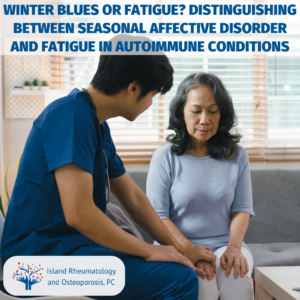Winter Blues or Fatigue? Distinguishing Between Seasonal Affective Disorder and Fatigue in Autoimmune Conditions
 As the days grow shorter and temperatures drop, many people experience changes in their mood and energy levels. For those with autoimmune conditions, it can be particularly challenging to differentiate between seasonal affective disorder (SAD) and fatigue related to their underlying condition. At Island Rheumatology & Osteoporosis PC, we aim to help our patients understand these distinctions and provide appropriate care.
As the days grow shorter and temperatures drop, many people experience changes in their mood and energy levels. For those with autoimmune conditions, it can be particularly challenging to differentiate between seasonal affective disorder (SAD) and fatigue related to their underlying condition. At Island Rheumatology & Osteoporosis PC, we aim to help our patients understand these distinctions and provide appropriate care.
Understanding Seasonal Affective Disorder (SAD)
Seasonal affective disorder is a type of depression that follows a seasonal pattern, typically beginning in late fall or early winter and improving during spring and summer. Symptoms of SAD may include:
- Persistent sad or low mood
- Loss of interest in activities
- Low energy and fatigue
- Changes in sleep patterns, often oversleeping
- Appetite changes, especially craving carbohydrates
- Difficulty concentrating
- Feelings of hopelessness or worthlessness
It’s important to note that SAD is a clinical form of depression that meets specific diagnostic criteria and can significantly impact quality of life.
Fatigue in Autoimmune Conditions
Fatigue is a common symptom in many autoimmune diseases, including rheumatoid arthritis, lupus, and fibromyalgia. This fatigue can be persistent and may not follow a seasonal pattern. However, some patients with rheumatic diseases report exacerbation of symptoms, including pain and fatigue, during certain seasons.
Distinguishing Between SAD and Autoimmune Fatigue
While both SAD and autoimmune-related fatigue can cause similar symptoms, there are key differences:
- Seasonality: SAD symptoms typically follow a predictable seasonal pattern, while autoimmune fatigue may be more constant or fluctuate independently of seasons.
- Mood Changes: SAD often involves significant mood alterations, including persistent sadness and loss of interest in activities. Autoimmune fatigue, while potentially affecting mood, may not cause the same degree of mood disturbance.
- Response to Light: People with SAD often show improvement with increased exposure to sunlight or light therapy, which may not have the same effect on autoimmune fatigue.
- Associated Symptoms: Autoimmune fatigue is often accompanied by other disease-specific symptoms, such as joint pain or inflammation, which are not typically associated with SAD.
When to Seek Help
If you’re experiencing persistent fatigue, mood changes, or worsening of your autoimmune symptoms during winter months, it’s important to consult with your rheumatologist. At Island Rheumatology & Osteoporosis PC, we can help determine whether your symptoms are related to your autoimmune condition, SAD, or a combination of factors.
Treatment Approaches
Treatment strategies may vary depending on the underlying cause of your symptoms:
- For SAD, treatments may include light therapy, psychotherapy, and in some cases, antidepressant medications.
- For autoimmune-related fatigue, management typically involves addressing the underlying condition through medication adjustments, lifestyle modifications, and symptom-specific interventions.
At Island Rheumatology & Osteoporosis PC, we’re committed to providing comprehensive care that addresses both the physical and emotional aspects of autoimmune conditions. By understanding the nuances between seasonal affective disorder and autoimmune-related fatigue, we can offer tailored treatment plans to help our patients thrive throughout the year.
Remember, whether you’re dealing with the winter blues or fatigue related to your autoimmune condition, you don’t have to face it alone. Our team is here to support you and help you maintain your quality of life, regardless of the season. Contact us today.

